Abstract
We have analyzed the DNA generated upon treatment of oviduct nuclei with pancreatic DNase I (deoxyribonucleate 3′-oligonucleotidohydrolase; EC 3.1.4.6), with cDNA copies of specific mRNA sequences to study the structure and organization of transcriptionally active genes in chromatin. In this report we examine the kinetics of digestion of three classes of genes in the oviduct which are transcribed at significantly different rates. Our results indicate that the ovalbumin genes appear to be organized by chromatin proteins in such a way that they are rendered exceedingly sensitive to digestion by DNase I. This sensitivity is not observed in the liver, a tissue in which these genes are transcriptionally inert. Furthermore, the transcriptionally inactive globin genes in the oviduct are not selectively sensitive to nuclease attack and are digested 5 times more slowly in the ovalbumin genes in this tissue. In addition, we have examined the accessibility of a complex subset of genes that are rarely represented in the mRNA and are likely to be transcribed at a frequency orders of magnitude below that of the ovalbumin gene. Comparison of the accessibility of these sequences with that of the ovalbumin gene indicates that these two subsets of genes are recognized and cleaved by DNase I at similar rates. These results suggest that the maintenance of an active conformation about specific genes does not reflect the polymerase distribution about these genes. This active conformation is therefore not confined to sequences actively engaged in the transcription process and may reflect the structure about a subpopulation of the genome which represents the transcriptional potential of a given cell type.
Keywords: chromatin structure, transcription, DNA reassociation
Full text
PDF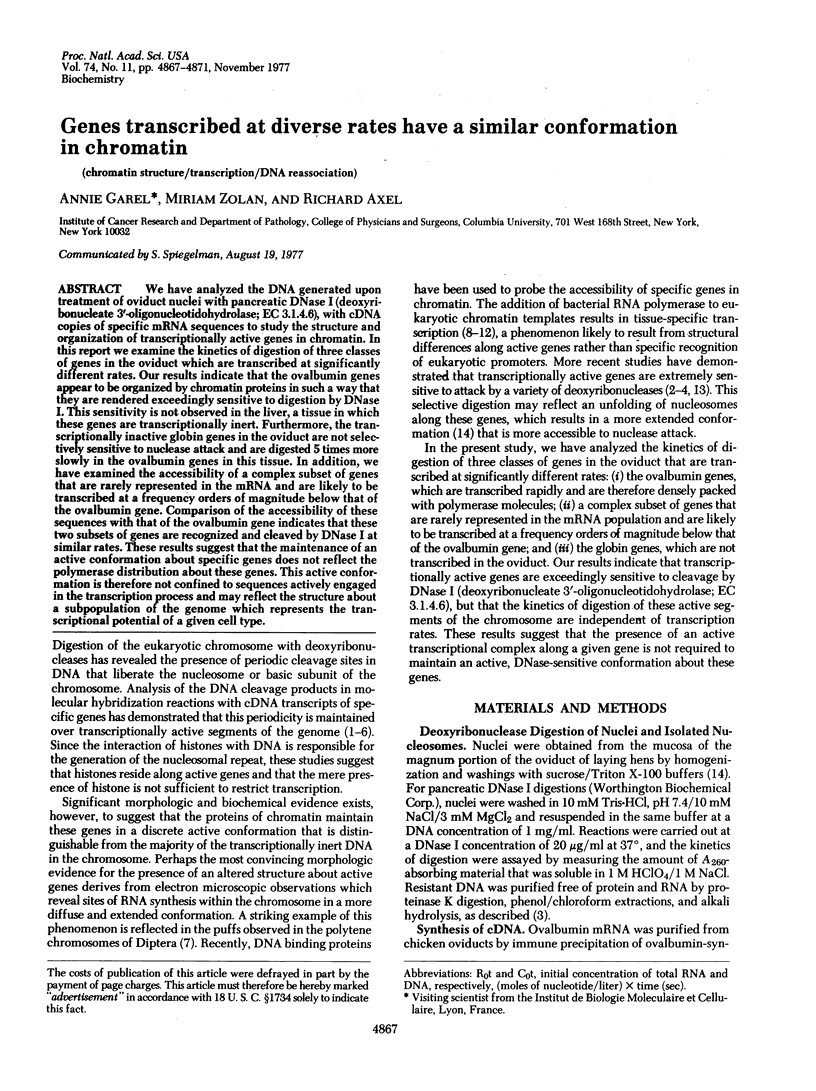
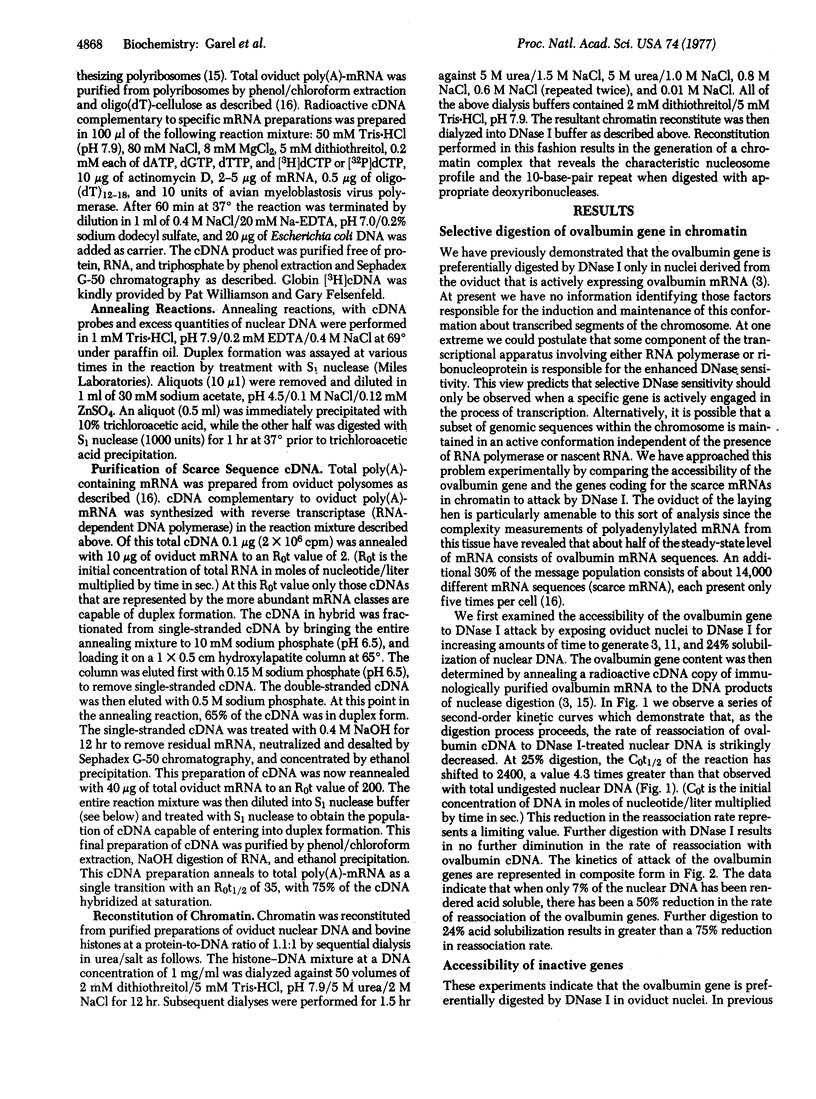
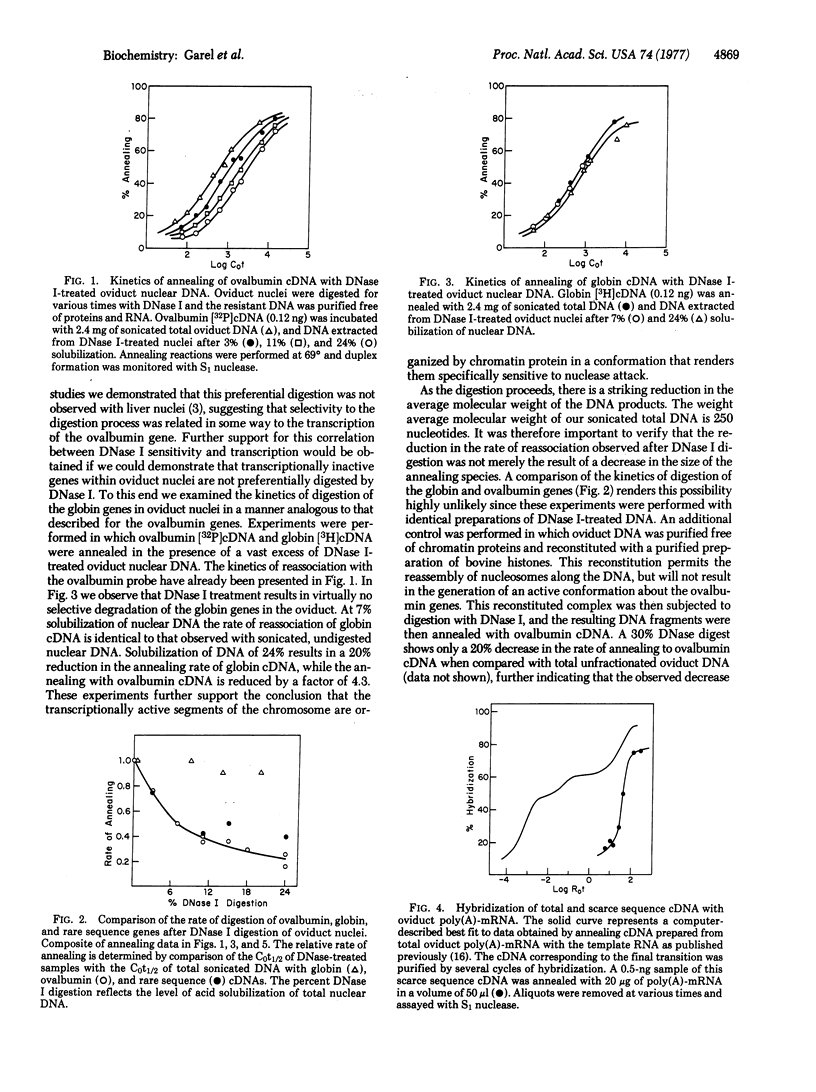
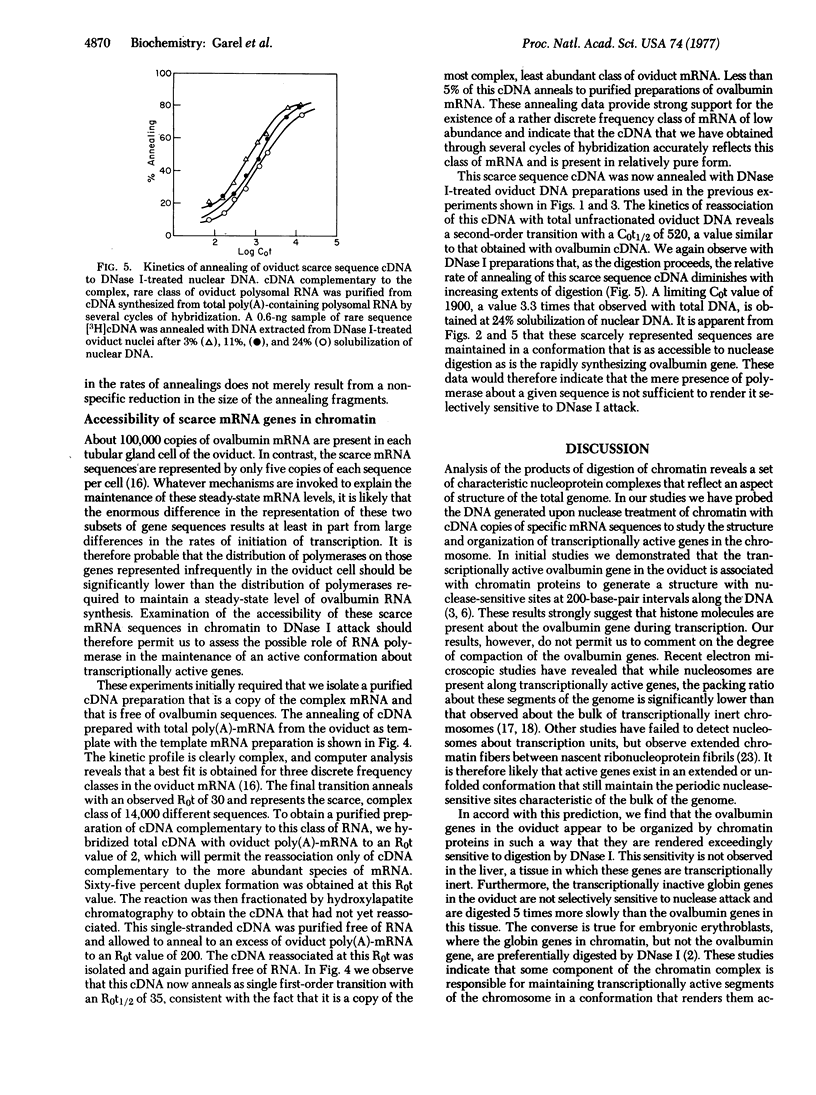
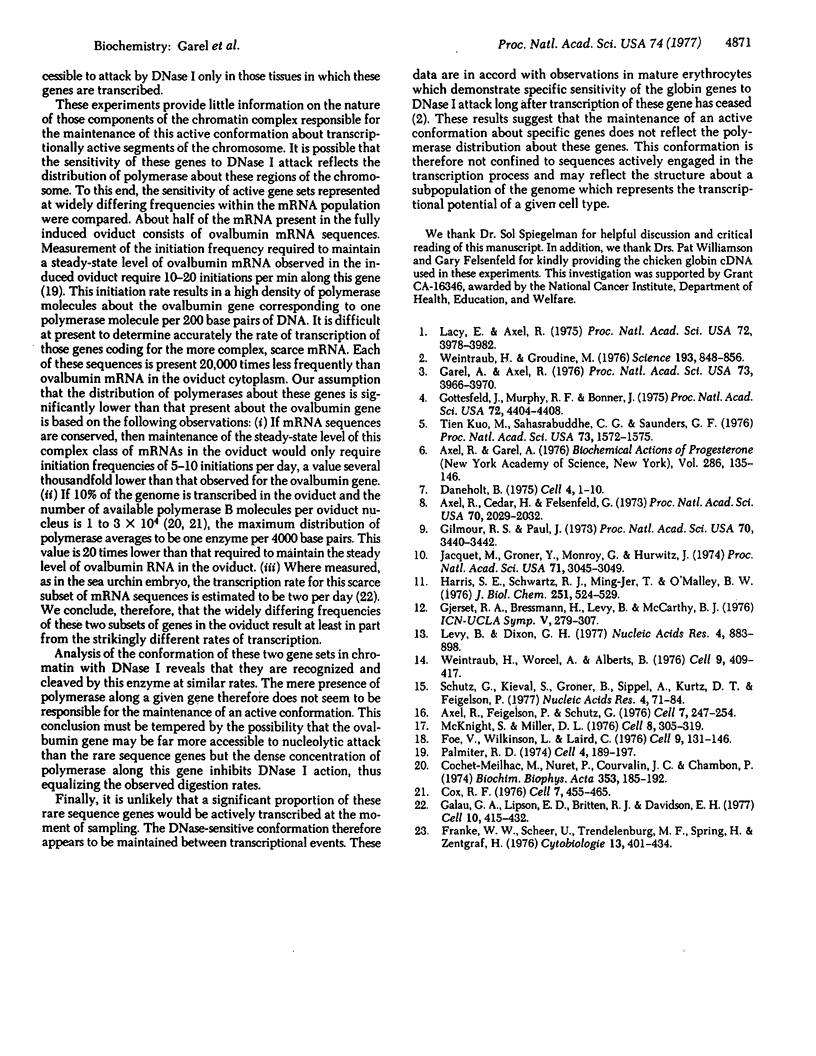
Selected References
These references are in PubMed. This may not be the complete list of references from this article.
- Axel R., Cedar H., Felsenfeld G. Synthesis of globin ribonucleic acid from duck-reticulocyte chromatin in vitro. Proc Natl Acad Sci U S A. 1973 Jul;70(7):2029–2032. doi: 10.1073/pnas.70.7.2029. [DOI] [PMC free article] [PubMed] [Google Scholar]
- Axel R., Feigelson P., Schutz G. Analysis of the complexity and diversity of mRNA from chicken liver and oviduct. Cell. 1976 Feb;7(2):247–254. doi: 10.1016/0092-8674(76)90024-6. [DOI] [PubMed] [Google Scholar]
- Axel R., Garel A. Structure of the ovalbumin gene in chromatin. Ann N Y Acad Sci. 1977 Mar 11;286:135–146. doi: 10.1111/j.1749-6632.1977.tb29412.x. [DOI] [PubMed] [Google Scholar]
- Cochet-Meilhac M., Nuret P., Courvalin J. C., Chambon P. Animal DNA-dependent RNA polymerases. 12. Determination of the cellular number of RNA polymerase B molecules. Biochim Biophys Acta. 1974 Jun 27;353(2):185–192. doi: 10.1016/0005-2787(74)90183-x. [DOI] [PubMed] [Google Scholar]
- Cox R. F. Quantitation of elongating form A and B RNA polymerases in chick oviduct nuclei and effects of estradiol. Cell. 1976 Mar;7(3):455–465. doi: 10.1016/0092-8674(76)90176-8. [DOI] [PubMed] [Google Scholar]
- Daneholt B. Transcription in polytene chromosomes. Cell. 1975 Jan;4(1):1–9. doi: 10.1016/0092-8674(75)90127-0. [DOI] [PubMed] [Google Scholar]
- Foe V. E., Wilkinson L. E., Laird C. D. Comparative organization of active transcription units in Oncopeltus fasciatus. Cell. 1976 Sep;9(1):131–146. doi: 10.1016/0092-8674(76)90059-3. [DOI] [PubMed] [Google Scholar]
- Galau G. A., Lipson E. D., Britten R. J., Davidson E. H. Synthesis and turnover of polysomal mRNAs in sea urchin embryos. Cell. 1977 Mar;10(3):415–432. doi: 10.1016/0092-8674(77)90029-0. [DOI] [PubMed] [Google Scholar]
- Garel A., Axel R. Selective digestion of transcriptionally active ovalbumin genes from oviduct nuclei. Proc Natl Acad Sci U S A. 1976 Nov;73(11):3966–3970. doi: 10.1073/pnas.73.11.3966. [DOI] [PMC free article] [PubMed] [Google Scholar]
- Gilmour R. S., Paul J. Tissue-specific transcription of the globin gene in isolated chromatin. Proc Natl Acad Sci U S A. 1973 Dec;70(12):3440–3442. doi: 10.1073/pnas.70.12.3440. [DOI] [PMC free article] [PubMed] [Google Scholar]
- Gottesfeld J. M., Murphy R. F., Bonner J. Structure of transcriptionally active chromatin. Proc Natl Acad Sci U S A. 1975 Nov;72(11):4404–4408. doi: 10.1073/pnas.72.11.4404. [DOI] [PMC free article] [PubMed] [Google Scholar]
- Harris S. E., Schwartz R. J., Tsai M. J., O'Malley B. W., Roy A. K. Effect of estrogen on gene expression in the chick oviduct. In vitro transcription of the ovalbumin gene in chromatin. J Biol Chem. 1976 Jan 25;251(2):524–529. [PubMed] [Google Scholar]
- Jacquet M., Groner Y., Monroy G., Hurwitz J. The in vitro synthesis of avian myeloblastosis viral RNA sequences. Proc Natl Acad Sci U S A. 1974 Aug;71(8):3045–3049. doi: 10.1073/pnas.71.8.3045. [DOI] [PMC free article] [PubMed] [Google Scholar]
- Lacy E., Axel R. Analysis of DNA of isolated chromatin subunits. Proc Natl Acad Sci U S A. 1975 Oct;72(10):3978–3982. doi: 10.1073/pnas.72.10.3978. [DOI] [PMC free article] [PubMed] [Google Scholar]
- Levy B., Dixon G. H. Renaturation kinetics of cDNA complementary to cytoplamic polyadenylated RNA from rainbow trout testis. Accessibility of transcribed genes to pancreatic DNase. Nucleic Acids Res. 1977 Apr;4(4):883–898. doi: 10.1093/nar/4.4.883. [DOI] [PMC free article] [PubMed] [Google Scholar]
- McKnight S. L., Miller O. L., Jr Ultrastructural patterns of RNA synthesis during early embryogenesis of Drosophila melanogaster. Cell. 1976 Jun;8(2):305–319. doi: 10.1016/0092-8674(76)90014-3. [DOI] [PubMed] [Google Scholar]
- Palmiter R. D. Quantitation of parameters that determine the rate of ovalbumin synthesis. Cell. 1975 Mar;4(3):189–189. doi: 10.1016/0092-8674(75)90167-1. [DOI] [PubMed] [Google Scholar]
- Schutz G., Kieval S., Groner B., Sippel A. E., Kurtz D., Feigelson P. Isolation of specific messenger RNA by adsorption of polysomes to matrix-bound antibody. Nucleic Acids Res. 1977 Jan;4(1):71–84. doi: 10.1093/nar/4.1.71. [DOI] [PMC free article] [PubMed] [Google Scholar]
- Tien Kuo M., Sahasrabuddhe C. G., Saunders G. F. Presence of messenger specifying sequences in the DNA of chromatin subunits. Proc Natl Acad Sci U S A. 1976 May;73(5):1572–1575. doi: 10.1073/pnas.73.5.1572. [DOI] [PMC free article] [PubMed] [Google Scholar]
- Weintraub H., Groudine M. Chromosomal subunits in active genes have an altered conformation. Science. 1976 Sep 3;193(4256):848–856. doi: 10.1126/science.948749. [DOI] [PubMed] [Google Scholar]
- Weintraub H., Worcel A., Alberts B. A model for chromatin based upon two symmetrically paired half-nucleosomes. Cell. 1976 Nov;9(3):409–417. doi: 10.1016/0092-8674(76)90085-4. [DOI] [PubMed] [Google Scholar]


